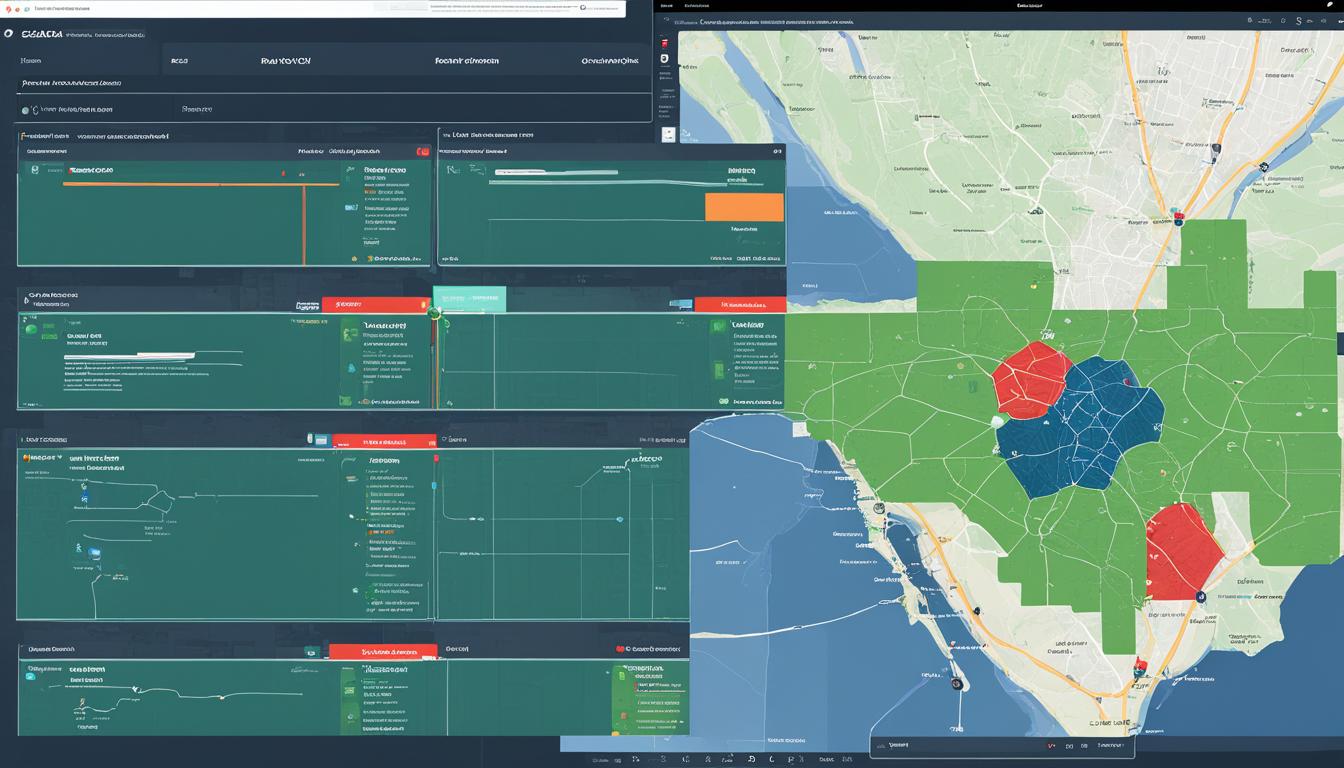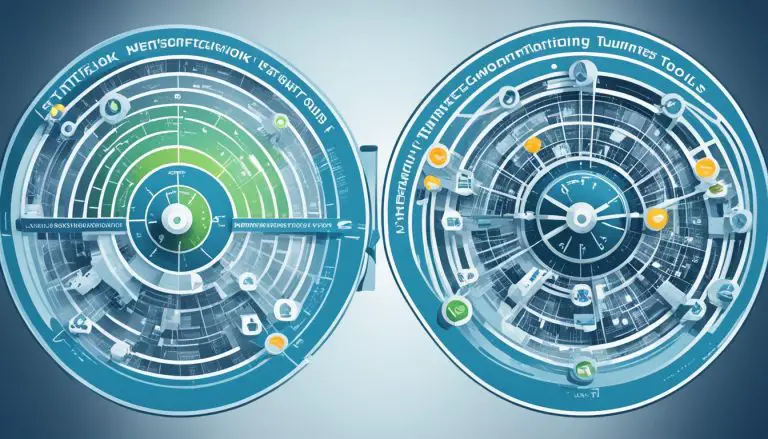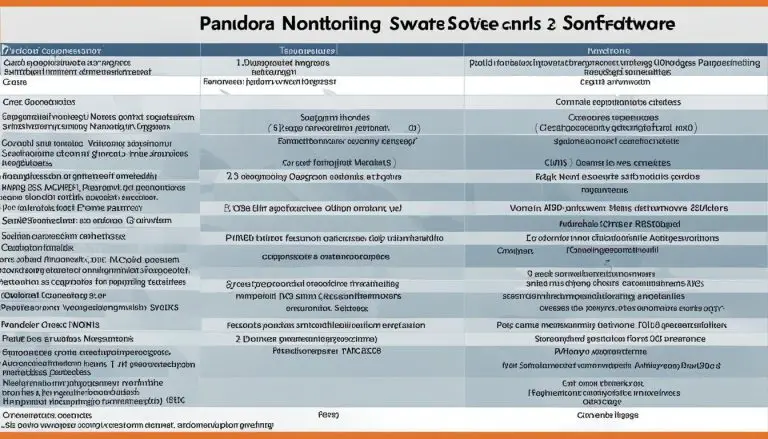Zabbix vs. Cacti: Which Monitoring Tool Wins?
When it comes to network monitoring tools, Zabbix and Cacti are two popular options that often come up for comparison. But which one is truly superior in terms of performance analysis, data visualization, and network management solutions? Let’s dive into a detailed comparison to find out.
Key Takeaways:
- Comparing Zabbix and Cacti can help identify the ideal network monitoring tool.
- Performance analysis and data visualization are crucial factors in choosing the right solution.
- Zabbix offers advanced features and scalability, while Cacti has certain limitations.
- Consider your organization’s specific needs and priorities before making a decision.
- Choosing the right alternative to Cacti requires thorough assessment and trial periods.
Limitations of Cacti
While Cacti has served as a reliable tool for basic network monitoring needs, it does come with its fair share of limitations that users should be aware of. These limitations primarily revolve around its outdated user interface and the lack of advanced features required for comprehensive network management.
One of the main concerns expressed by users is the outdated user interface of Cacti. The interface tends to feel clunky and unintuitive, making it challenging for users to navigate and access the information they need efficiently. This can result in a less-than-optimal user experience and hinder productivity.
Furthermore, Cacti lacks advanced features that are becoming increasingly important in modern network management. While it excels at basic monitoring tasks, it falls short when it comes to providing advanced functionality such as automated alerting systems, real-time data visualization, or customizable dashboards. Without these advanced features, users may find it difficult to effectively monitor and manage their networks in a dynamic and ever-changing environment.
“Cacti’s user interface feels outdated and clunky, making it cumbersome to navigate and retrieve information quickly. Additionally, the lack of advanced features such as automated alerts and customizable dashboards makes it challenging to keep up with the evolving demands of network management.” – Network Administrator, XYZ Company
Despite these limitations, it is important to note that Cacti has its strengths in certain areas, specifically in its ability to offer basic network monitoring capabilities. However, organizations seeking a more comprehensive and advanced network management solution may find that Cacti falls short.
Next, we will explore the key features to look for in Cacti alternatives that address these limitations and provide a more robust network monitoring experience.
Key Features to Look for in Cacti Alternatives
When considering alternatives to Cacti, it’s crucial to prioritize key features that enhance your monitoring experience. Look for alternatives that offer an intuitive user interface, advanced data visualization capabilities, and customization options to tailor the solution to your specific needs.
An intuitive user interface is essential for ease of use and efficient navigation. It allows you to quickly access vital information and perform necessary configurations without any hassle. A user-friendly interface saves time and minimizes the learning curve, enabling you to focus on network monitoring tasks.
Advanced data visualization capabilities play a vital role in understanding the performance of your network. Look for alternatives that provide visual representations such as charts, graphs, and maps, enabling you to analyze data effectively. These visualizations help you identify trends, anomalies, and potential bottlenecks, empowering you to take proactive measures.
“Effective data visualization is the key to unlocking insights and making informed decisions about your network’s performance.” – Network Monitoring Expert
Customization options allow you to tailor the monitoring solution to meet your unique requirements. Look for alternatives that offer flexible customization features, such as customizable dashboards and reports. The ability to customize alerts and notifications according to your specific needs ensures that you receive the right information at the right time.
By focusing on these key features, you can find alternatives to Cacti that provide a user-friendly interface, advanced data visualization capabilities, and customization options to optimize your network monitoring experience.
Top Alternatives to Cacti
Cacti is a popular network monitoring tool, but there are several alternatives that offer robust features and capabilities. If you’re looking to explore other options, here are some of the top alternatives to consider:
-
Grafana
Grafana is a powerful open-source software that provides advanced data visualization and analytics. With its user-friendly interface, Grafana allows you to easily monitor and analyze network performance metrics in real-time.
-
Zabbix
Zabbix is a popular network monitoring and alerting system that offers a wide range of features including performance analysis, scalability, and customization options. It provides comprehensive network management solutions and is known for its flexibility and user-friendly interface.
-
Nagios
Nagios is a widely-used open-source network monitoring tool that offers strong monitoring capabilities. It allows you to monitor network devices, services, and applications, and provides timely alerts for issues or outages.
-
PRTG Network Monitor
PRTG Network Monitor is a comprehensive network monitoring solution that offers a wide range of monitoring capabilities, including network traffic analysis, device monitoring, and performance monitoring. It provides a user-friendly interface and is suitable for both small and large-scale networks.
“These alternatives provide advanced visualization, scalability, and customization options, making them competitive options for network monitoring and management.”– Network Monitoring Expert
When considering alternatives to Cacti, it’s essential to evaluate your specific requirements and prioritize the features that align with your network monitoring goals. Whether you choose Grafana, Zabbix, Nagios, or PRTG Network Monitor, these alternatives offer powerful capabilities to enhance your network monitoring and management activities.
Comparison of Cacti and Alternatives
When comparing Cacti to its alternatives, factors such as pricing, scalability, and ease of use come into play. While Cacti is an open-source and free network monitoring tool, it’s important to explore other options to determine the best fit for your organization.
Pricing
In terms of pricing, Cacti stands out as a cost-effective choice since it is free to use. However, some alternatives may require a subscription or licensing fee, depending on the specific features and capabilities they offer.
Scalability
Scalability is a crucial consideration when choosing a network monitoring tool. While Cacti can handle smaller networks efficiently, it may face challenges when scaling up to larger environments. In contrast, certain alternatives like Zabbix and PRTG Network Monitor offer robust scalability features, making them suitable for organizations with complex and extensive networks.
Ease of Use
The ease of use of a monitoring tool greatly impacts its effectiveness in network management. Cacti provides a user-friendly interface that is relatively easy to navigate, making it accessible to both beginners and experienced users. However, some alternatives, such as Grafana and Zabbix, offer more advanced features that could require a learning curve for new users. They make up for it by providing extensive documentation and user communities to support the learning process.
Ultimately, the decision between Cacti and its alternatives depends on your organization’s specific needs and requirements. While Cacti is a reliable choice for basic network monitoring, alternatives may offer more advanced features, improved scalability, or additional customization options. Consider the pricing, scalability, and ease of use factors when making your selection.

How to Choose the Right Alternative
When it comes to selecting the right alternative to Cacti, it’s crucial to assess your organization’s specific needs and requirements. By considering factors such as budget constraints, desired customizability, and community support, you can make an informed decision that aligns with your network monitoring goals.
One effective way to evaluate potential alternatives is by taking advantage of trial periods and demos. These opportunities allow you to test the features and functionalities of different tools, giving you a hands-on experience to assess their suitability for your organization.
During the trial period, pay close attention to how well the alternative meets your network monitoring needs. Assess its performance in areas such as data visualization, scalability, and ease of use. Consider whether the alternative offers the same level of accuracy and detail that Cacti provided, or if it surpasses these capabilities.
Furthermore, community support plays a vital role in the success of any monitoring tool. Look for alternatives that have an active and engaged community of users and developers. This ensures that you can rely on ongoing support, updates, and access to an extensive knowledge base to address any challenges that may arise.
Ultimately, the right alternative for your organization will depend on your unique needs and preferences. By carefully assessing your requirements, taking advantage of trial periods, and considering community support, you can make an informed decision that optimizes your network monitoring capabilities.
Implementing the Chosen Alternative
Now that you’ve selected the perfect alternative to Cacti, it’s time to move forward with its implementation. In this section, I’ll guide you through the necessary steps to ensure a smooth transition to your new monitoring tool.
1. Installation Process
The first step in implementing the chosen alternative is to install the software. Follow the installation instructions provided by the vendor, which typically include downloading the necessary files and running the installation package. Be sure to meet the system requirements specified by the alternative to guarantee compatibility and optimal performance.
2. Configuration Steps
After the installation is complete, you’ll need to configure the alternative to align with your specific requirements. This involves setting up monitoring parameters, defining thresholds, and customizing dashboards to display the data you need. Take full advantage of the alternative’s features and options to tailor the monitoring experience to your organization’s unique needs.
3. Data Migration
If you have existing data in your Cacti instance that you want to preserve, migrating it to the new alternative is essential. Follow the data migration guidelines provided by the vendor, which may include exporting your data from Cacti and importing it into the new solution. Ensure that the migrated data is accurate and properly integrated into the alternative’s database for seamless continuity.
“Implementing an alternative to Cacti requires a careful and systematic approach. From installation to configuration and data migration, each step plays a crucial role in the successful adoption of your new monitoring tool.”
Remember, the implementation process may vary depending on the chosen alternative and your specific environment. It’s always a good practice to consult the vendor’s documentation or seek assistance from their support team if you encounter any difficulties during the implementation process.
Conclusion
After analyzing the features and capabilities of both Zabbix and Cacti, it is clear that choosing the right network monitoring tool depends on the specific needs of your organization. While Cacti may have its limitations, alternatives like Zabbix offer more flexibility and scalability, making them suitable for managing complex networks.
When it comes to network monitoring, it is crucial to select a tool that can effectively meet your requirements. Consider factors such as the need for advanced features, user-friendly interfaces, and data visualization capabilities. Zabbix provides a comprehensive solution that allows for efficient network performance analysis and monitoring.
In conclusion, when making a decision between Zabbix and Cacti, prioritize your organization’s goals and objectives. By choosing the right tool that aligns with your specific network monitoring needs, you can ensure optimal performance and proactive issue resolution for your network infrastructure.
FAQ
What are the limitations of Cacti?
What key features should I look for in Cacti alternatives?
What are some top alternatives to Cacti?
How do Cacti and its alternatives compare?
How can I choose the right alternative to Cacti?
How do I implement the chosen alternative to Cacti?
- About the Author
- Latest Posts
Mark is a senior content editor at Text-Center.com and has more than 20 years of experience with linux and windows operating systems. He also writes for Biteno.com





